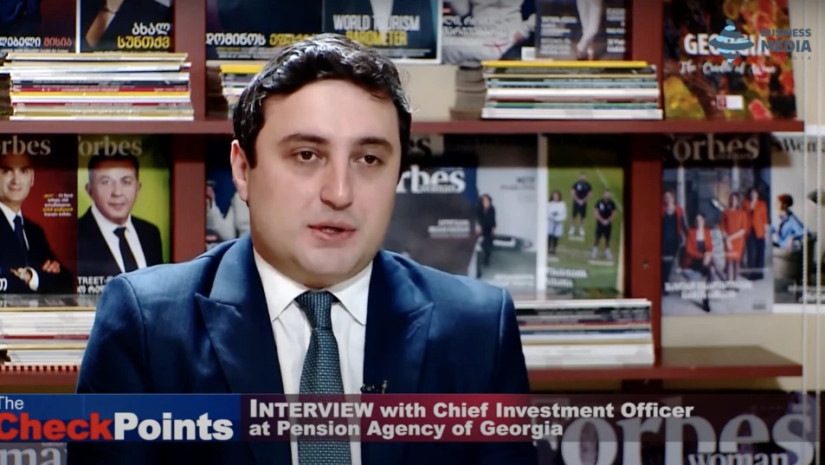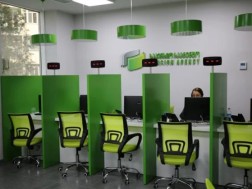Since 2019, after the accumulative pension system was launched in the country, the figures show that the earnings are 5% higher than the inflation in the same period. The Checkpoints set down with the Chief Investment Officer Goga Melikidze for a brief SWOT-analysis of the system and the agency performance now and going forward.
Dear Goga, thank you for being with us and taking our questions. Let us start with current figures – what are the main figures today and what do they tell you about the Agency performance overall?
Thank you for having me. Presently, we have been generating around 11.4% as of now – this is the current effective annual yield. But most importantly we need to measure the net asset value in terms of the investment time horizon. Since launching the Fund – it was January 2019 we have been generating 28% while the inflation is 22%. Our objective is to over perform the inflation and in this direction we are doing quite successfully so far. We are overbeating the inflation by 6% as of now.
What does the special depositary change in the overall picture?
The role of the special depository is very critical. It is required by the law and it is not really the Georgian know-how to have the special depository in the investment infrastructure. It is international practice and standard so that before this we were not able to invest in capital market instruments, and now we can. Before we were mostly investing in cash equivalents and now we can invest in capital markets globally, locally and everywhere.
Following my previous question, and your focus right now – when will you actually start investing in corporate and government bonds and you also mentioned international markets and what is your target there?
We will be utilizing this limit that we have as per the law 20%- so that we will be investing at least 20% of our portfolio abroad – meaning mostly global equities: we will not be investing in global fixed income because fixed income in hard currency denominated yielding very low rate of return; mostly, we will be investing in equities, and shares and stocks. The law gives us the 20% limit – so we will be using that limit 100% and we will start doing it as soon as possible. Well, at the moment we are spending most of our time to build up the infrastructure with the special depository. So far we were negotiating the deal – we closed the agreement and now we are building and testing the operational side of the infrastructure and once it is over and it will be over very soon, we will be investing globally and we will be overseeing it on a local market where we can invest. So far, just to give you more details about our investment strategy, we are quite skeptical about the secondary market that we have in the country – meaning the corporate bonds. Why? Because it is very small and given our limited investment mandate we cannot really invest in most of them, and if we check our investment universe – local corporate bonds mostly – we can only invest up to GEL 100 million – that’s what we have on the secondary market – so, we are looking at the primary market transactions more and we will be considering all kind of bond issuances that we will have on the market this year, next year and going forward. Some of them might not be eligible – given our investment mandate, investment requirements and operational limits – but still, we will be watching them at least from the interest rate perspective. We will be mostly concentrated on primary market transactions – corporate bonds, it there’s any equity but I doubt that – as for the Eurobond markets- I mean the Eurobonds issued by Georgian companies – we don’t watch them aggressively because the yield on them is very low.
What should be the yield?
This is a very good question, by the way. We are interested in all kinds of yields in the sense that mostly it should be Georgian – I mean, Lari denominated yield. We are interested in fixed rate yield as well as floating rate yields. As for the fixed rate, it’s hard to say I mean when it comes to invest, we have to analyze by that time that but to give you a very broad and blended picture we are interested in a refinancing plus at least 2.5-3% fixed rate 24 months, 36 months – I mean, two years, three-year maturity. So, we are interested in both yields – fixed rate plus floating rate.
You mentioned several times that at this point you’re not watching aggressively the local market but have you identified what type of companies might be of interest to you say in future?
We are monitoring the investment universe very much – corporate bonds, IFI bonds and Eurobonds plus international markets. Given our investment mandate is quite tight as we all know; we have a lot of requirements – we will be interested in all kinds of companies that will be eligible for our investment mandate. It really doesn’t matter whether it is from specific sector – bank or non-bank industry; state owned, maybe – if the company is good, if it has a compelling business model, strong PNL, strong financials, convincing management – we are open to consider.
Right now we know that for example, GSE (Georgia State Electro system company) is thinking of issuing bonds…
Actually, I have never seen the financials of this company. If the company decides to issue bonds – they have to produce a prospectus which is a book on the company, we will be checking the prospectus. If the company has the decent credit rating – for sure we will be interested in it. It’s hard to say from this perspective but once it is available and if the company has a decent financials and good business model and compelling business plan- why not?
I’m asking these questions because if you look at different international organizations, development agencies, International Financial Institutions – they all kind of make emphasis that this long-term Lari might be interesting for developing capital markets in Georgia in the future. Do you see this direct link to it?
You are absolutely right and this is also a very good question. In order to develop capital markets, we really need a long-term Lari investment capital – this is a very critical condition to develop the capital market but this cannot be the solution for everything. I usually come across this kind of question that – you have long-term Lari, where is the capital market development?
And it’s our Lari…
It is very critical angle and very critical condition that we need to develop the capital market but to have the good development of the capital market we need other factors as well. It is a complex project – let’s put it in this way – economy’s small and when the economy is small it is a critical challenge for the development in a proper way; however, this doesn’t mean that we cannot have a developed capital market. On one hand we need to be talking to the issuers – companies to issue the bonds and kind of convince them to issue the bonds and equities; on the other hand, we need to be talking to other financial investors and portfolio investors to invite them in Georgia and either convince them to invest in Georgia or invest internationally via Georgia – so, it’s a kind of a complex project – a lot of moving parts to be dealt with at the same time. The long term Lari capital is must and we already have it and this is a very good move forward, and now we have to deal with other parts that are also needed to develop capital market.
What about the de-dollarization of the system because that’s another emphasis from these organizations that somehow this could speed up this process…
Pension Fund so far has been contributing to de-dollarization a lot because we are 100% Georgian Lari yield and we are 100% invested in Georgian banks. Given the content of the dollarization and what it’s all about, pension fund already contributes a lot. We really increased a lot Georgia Lari deposits in these banks. We contribute a lot and we will continue doing so – however, as I said in the beginning we will be using our 20% limit and we will invest globally at least 20% of our portfolio.
In the beginning of our conversation you mentioned inflation and how that affects long-term savings and during the pandemic we see that Georgia hits new record highs of inflation – what is the strategy there and how you have been curbing this impact of inflation on savings?
Inflation is a general challenge for the world right now. And Georgia has been facing high inflation – to take the history of the past 20 years this is the second-high inflation that we have been facing and this is quite objective reality that we have locally, globally. And the way we hedge inflation is that we keep at least 33% of the portfolio in the floating rate investment and we buy high interest rate at the same time. So, 67% of the portfolio we invest at a high interest rate now and we still maintain 33% of the portfolio inflation-linked. That’s how we hedge inflation at the moment. If we see that inflation becomes systematic and it is no longer a periodic and we see that the inflation is translated into a systematic condition, then we will increase our allocation to inflation-linked floating rate. But since we believe according to our macro analysis, we really believe that the National Bank of Georgia (NBG)’s expectation is right that this is a periodic inflation and from the second half of 2022 we will see the declining inflation trend – given this macroeconomic situation, we try to on one hand benefit of it so to buy high interest rate as much as we can and on the other hand, as I said, we maintain at least 30% (now we have 33%) in the floating rate in order to be kind of linked to the inflation. The way we do it, when we negotiate floating rate deal we usually tell the bank or when the corporate bonds are available we will have the same approach, that the rate should be linked to the refinancing rate and if it is so, it is a floating rate investment. If the inflation is systematic, refinancing rate will be reading the inflation for sure and will be going up or down.
Now that you will be investing more actively and the pension agency will start working at a full swing what are some of the main challenges that you will be looking at because you know that in the wake of this reform there was a big debate whether it’s risky, whether Georgia being a post-Soviet country can handle this reform and many more. So, what are some of the challenges that you are currently weighing in and looking at?
That’s a very good question, indeed. The major challenge that we have been facing is the tight investment mandate which is right on one hand and challenging on the other hand. For example, we cannot invest below one notch below the credit rating. Country credit rating is BB – we can invest in BB or BB- only, as of now. That really narrows down our investment universe – this is one. Another one is concentration limits: We cannot invest more than 10% of the single issuance and so on and so forth. That’s why we are in a talks with the National Bank to ease down the regulations to some extent for some period of time, at least in order to have more room for investing and to increase our investment universe that we have so far. Because 20% we can invest abroad and the rest 80% must be invested in Georgia and in low-risky instruments. We don’t have capital market in this country at all; equity market is completely not here and if we check the fixed income market – as I say, local corporate bond market is very small and given our tight mandate it becomes even smaller and Eurobonds issued by Georgian companies are good and liquidity is there, but however, yield is so low that they are not interesting at all.
What is logic behind these constraints?
Logic is quite rational. Logic is to invest in low-risk instruments and since the reform is very new – it has been on the market over the past three years – that’s why the law very explicitly says that the pension savings must be invested in the low-risk instruments. That’s the rationale behind this. And it is quite right. On the other hand, we really need investment universe and that’s why I think that we may amend a law a little bit in order to have more room and more scale for investing and to increase our investment universe.
And you are currently in talks with the NBG, right?
We are currently working with the regulator on this matter and with the investment board as well and we may be able to change or amend it to some extent, or not. As of now we have banks where we deploy our saving and banks provide good risk-adjusted return. We might be investing in government treasuries. And we will be considering all kind of capital market transactions – mostly, corporate bonds - local Georgian Lari corporate bonds. And the rest 20% we will be investing globally. And as for the global investing, we have selected this MSCI world Index – this is a Morgan Stanley World Index – a quite diversified global Index – we have selected several mutual funds and ETFs that follow them and we will be investing in them. So, in the beginning in terms of the global investing we will be following a quite passive investment strategy – it will be Index investing – we will buy ETF that is following the Index and that will be our approach in terms of global investment because we have to be doing it as I say with quite low risky approach.
Basically, you will be maintaining the same logic that we have been talking about…
When it comes to invest in medium-risky portfolio and high-risky portfolio then there might be some stock picking globally but as of now the next year and a half until we have to be under the low-risk portfolio, we will be doing Index investing which is a passive investment strategy.
Can we please calculate for our viewers – if we take an average salary which is around 1300 Lari – what would be the saving?
We have this calculator and we will be launching version 2 of this calculator very soon, but as per the current calculator, if a person has say a 1000 Lari salary and the participant is 30 years old, by the time he/she gets retired, her/his saving will be up to 200 K and monthly it will be like in the range of 1500 to 2000 Georgian Laris – depends on salary rise, depends on ROI – but we think that if we combine Pillar 1 paid from the state budget and our pension system Pillar 2, we think that it will be twice as much payment as the salary that the participant currently gets. There are a lot of inputs and assumptions when you do the calculation of the pension calculator and it’s very hard to do the specific calculation but according to current expectation given the features we have identified earlier, there is a chance for saving twice as much as a current salary on a monthly basis.
If you were ranking Georgia where would you put our country on the pension reform map globally or regionally – you pick…
Last year we did quite well as per the OECD report, and this report is already available and we will be publishing some infographics on that. We made 7% of real return which is the third in the World. Only Mexico and Hong-Kong did better than us but you know OECD covers more than 200 countries and we were third in 2020. The report for 2021 will be available in 2022. Let’s see how we did. But in 2020 we did pretty good and as for the asset growth, we were number one in the World.
Base effect is still there, right?
Yes, the base was very low. Asset went up by 128% - I doubt that such a pace can be maintained going forward but ROI and real return is very important and according to this profitability numbers and performance we did quite well last year. Let’s see how we do this year as per this independent appraisal.
Well, we’ll see you with that topic then, again in The Checkpoints.
Absolutely. Thank you.
















